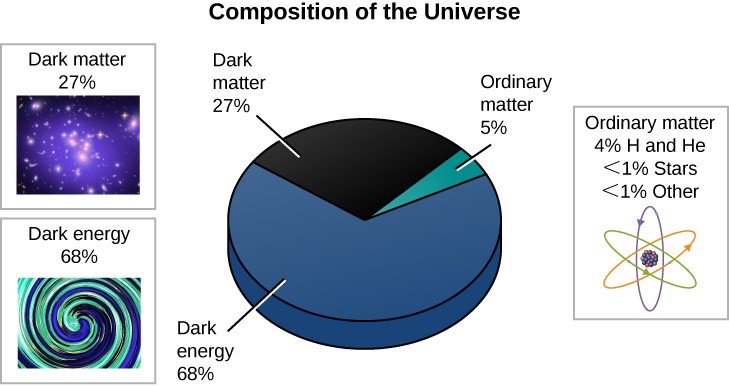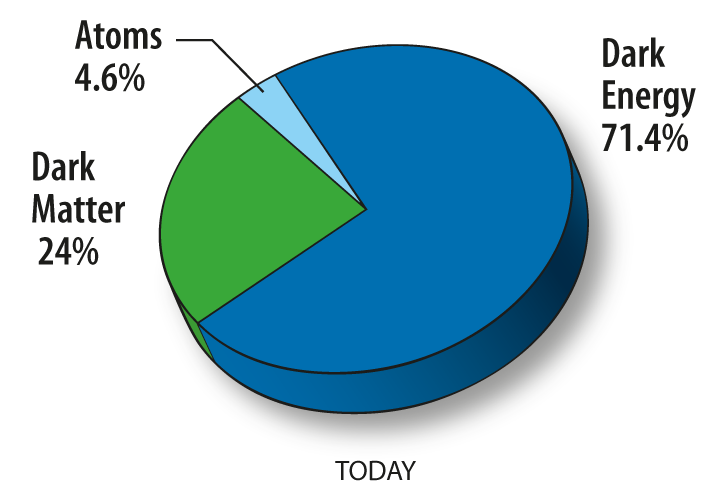The Enigma of the Universe: Uncovering the Secrets of Dark Matter and Dark Energy
Dark matter and dark energy are widely regarded as two of the most mysterious phenomena in the universe. Scientists posit the existence of hypothetical forms of matter and energy in the universe due to their presumed gravitational influence on observable phenomena in the cosmos. The prevailing notion is that dark matter constitutes roughly 85% of the total matter in the universe, while dark energy is postulated to account for approximately 68% of the overall energy content of the cosmos. Despite extensive research spanning several decades, scientists continue to encounter difficulties in comprehending the characteristics and properties of dark matter and dark energy.
Dark matter and dark energy are considered enigmatic phenomena in contemporary cosmology due to their elusive nature and the difficulties associated with their detection and investigation. Cosmology is a field of study that focuses on the origins and characteristics of the universe.
The existence of dark matter is postulated based on its gravitational influence on observable matter. Nevertheless, dark matter exhibits no discernible interaction with electromagnetic radiation, including light. The elusive nature of the subject matter has posed a significant challenge for scientists, who have resorted to deducing its existence based on the gravitational impact it exerts on observable celestial bodies throughout the universe. The scientific pursuit of detecting dark matter particles has persisted for numerous years, with innumerable endeavors undertaken, yet direct observation of said particles has not been achieved as of yet.
Similarly, the characteristics and origins of dark energy remain elusive, despite its hypothesised role in driving the universe's rapid expansion. This renders it an intriguing phenomenon. In contrast to the uneven distribution of dark matter throughout the cosmos, dark energy is believed to exert negligible influence on observable matter. The task of locating and studying it is considerably arduous because researchers are compelled to rely on indirect measures to apprehend its features.
What is Dark matter
The term "dark matter" refers to a hypothetical form of matter that is believed to exist due to its gravitational effects on visible matter but does not emit, absorb, or reflect electromagnetic radiation, making it invisible to telescopes and other instruments that detect electromagnetic radiation.
The prevailing hypothesis posits that a significant proportion, approximately 85%, of the matter present in the universe is constituted of an enigmatic substance referred to as "dark matter," the precise nature of which remains unknown. Scientists have inferred the existence of dark matter based on its hypothesized gravitational influence on observable matter in the universe.
The observations of the motions of galaxies, galaxy clusters, and other cosmic structures imply the existence of a greater amount of mass than what is congruent with discernible matter, such as gas and stars. This phenomenon can be attributed to the fact that the observable entities are insufficient to explain the detected movements of these macroscopic formations. Due to its lack of interaction with electromagnetic radiation, the presence of dark matter remains elusive to telescopic detection, as it remains invisible to these instruments.
Physicists infer the existence of dark matter through the gravitational effects exerted on visible matter. Galaxies exhibit a higher rotational velocity than what is expected from their observable matter content, indicating the presence of non-luminous matter. Analogously, the phenomenon of gravitational lensing, wherein the light undergoes distortion during its passage through galaxy clusters, serves as a corroborating indication of the existence of a substantial amount of non-luminous matter.
The elusive nature of dark matter particles has been the focus of extensive research efforts over a considerable period of time. Despite concerted efforts, scientists have yet to directly observe these particles. Nevertheless, a substantial corpus of evidence indicates the presence of dark matter, which remains a highly enigmatic issue in modern cosmology.
Let us explore the hypotheses regarding the composition of "dark matter".

Source
Researchers have put forth a wide range of alternative hypotheses regarding the characteristics of dark matter, as well as candidates for its composition. Axions and weakly interacting massive particles (WIMPs), an abbreviation for weakly interacting particles, are two of the most notable conjectures.
Hypothetical particles known as weakly interacting massive particles (WIMPs) are postulated to exhibit minimal interaction with other forms of matter. It is widely believed that they possess a significantly higher mass compared to that of a proton. In the 1970s, there was a hypothesis proposed to account for the excess mass observed in galaxy clusters. This was the first instance where this observation was utilized to provide evidence for their existence. Theoretical subatomic particles known as WIMPs are believed to engage in interactions with other particles through the weak nuclear force, which is among the fundamental forces that regulate the natural world. Numerous endeavors have been made to detect weakly interacting massive particles (WIMPs) through experimental means; however, none have yielded positive results thus far.
Axions are a postulated class of particles that have been put forth as a potential contender for the elusive dark matter. During the 1970s, an endeavor was undertaken to surmount the challenge posed by the theory of strong nuclear forces by employing these concepts for the first time. It is postulated that axons possess a significantly lower mass in comparison to electrons, thereby rendering them a highly lightweight entity. It is expected that their interaction with matter and radiation would be extremely feeble, thereby exacerbating the challenge of their detection. Nevertheless, certain scholars hold the view that it could be feasible to indirectly perceive axion activity through the observation of its interaction with magnetic fields.
Additional conjectures concerning the constitution of dark matter encompass the presence of sterile neutrinos and dark photons. Sterile neutrinos are a theoretical class of particles that exhibit no interaction with any other form of matter. Conversely, dark photons are a hypothetical class of particles that interact with both visible and dark matter through electromagnetic force. Nevertheless, none of these conjectures has been substantiated, and the exploration of the attributes of dark matter persists as a dynamic domain of inquiry in the realms of astrophysics and particle physics.
A variety of methodologies, such as gravitational lensing and particle detectors, are employed by scientists in their investigations of dark matter.
Gravitational lensing is a phenomenon whereby the gravitational pull of massive objects, such as galaxy clusters, causes the bending and distortion of light originating from distant galaxies. By utilizing light distortions as an observational tool, astronomers can deduce the existence of dark matter and trace the distribution of mass within a galaxy cluster. By employing this technology, accurate cartographies of the dispersion of dark matter across the cosmos have been produced.
The particle detector is an additional apparatus employed in this field of study. The detectors in question have been designed to detect rare instances of interaction between dark matter particles and ordinary matter. The direct detection methodology is widely used as the predominant type of detector. The experiment involves the use of a large container filled with either gas or liquid to detect the minuscule amounts of heat or light that arise from the collision between a dark matter particle and a nucleus present within the detector. The collision between a nucleus in the detector and a dark matter particle results in the generation of small quantities of heat or light. Currently, several direct detection experiments are being conducted in various regions across the globe. Several experiments have been conducted, such as XENON, LUX, and PandaX.

Source, XENON.
Indirect detection experiments represent an additional approach to scrutinizing the properties of dark matter. The objective of these investigations is to identify the resultant substances generated by the process of dark matter annihilation, which occurs when particles of dark matter interact and mutually annihilate. Examples of such secondary products include gamma rays and neutrinos. The Fermi Gamma-Ray Space Telescope and the IceCube Neutrino Observatory are examples of indirect detection investigations.
Two additional methodologies for exploring the properties of dark matter involve the utilization of cosmic microwave background radiation, remnant radiation from the Big Bang, and the examination of the universe's large-scale structure. Various methodologies have provided valuable insights into the characteristics of dark matter; however, the exact properties of this elusive constituent remain elusive to the scientific community.
Several challenges and limitations are associated with investigating dark energy.
The elusive nature of dark matter, owing to its feeble interaction with regular matter, poses a formidable challenge for researchers seeking to gain further insights into its properties. Direct detection of dark matter remains a daunting task. As a consequence, scientists have been compelled to resort to indirect detection methods, such as investigating the gravitational impacts exerted by dark matter on observable matter.
The exact location of dark matter is challenging to ascertain due to its seemingly widespread distribution throughout the universe. This presents another obstacle that requires resolution. The Large Hadron Collider and the Dark Energy Survey are two examples of how the search for dark matter has led to the development of extensive scientific investigations. These initiatives aim to detect dark matter indirectly by scrutinizing its impact on other particles or celestial bodies. The investigations conducted possess the capability to elucidate the characteristics of the elusive dark matter.
Furthermore, there exists a significant amount of ambiguity regarding the fundamental properties of dark matter, including its exact constitution and its behavior in diverse scenarios. As a result, the task of devising innovative detection techniques or models that can accurately predict its behavior is becoming increasingly arduous.
The role of dark matter in the formation of the universe's structure remains a subject of intense debate. Scientists have proposed a number of alternative theories as potential explanations for gravitational phenomena that do not rely on the existence of dark matter. The investigation of dark matter is a challenging task that necessitates persistent research efforts to arrive at a definitive conclusion.
Despite the challenges and limitations, scholars are persisting in their exploration of dark energy, intending to attain a more profound understanding of its characteristics and its role in the genesis of the cosmos. Novel telescopes and observational methods are currently under development to facilitate the progression of our comprehension of dark energy and its impacts. Examples of such projects include the Large Synoptic Survey Telescope and the Euclid Project.
What is Dark Energy
The concept of dark energy refers to a hypothetical form of energy that is believed to permeate all of space and is responsible for the accelerating expansion of the universe.
The existence of a cosmic energy called "dark energy" has been postulated. The postulation of a force called "dark energy" has been attributed to the accelerating expansion of the universe. Scientists who looked at far-off supernovae in the late 1990s made a significant discovery that showed the cosmos is not only expanding but doing so at an increasing rate. The outcome was unexpected, as the scientific community had previously postulated that the universe's accelerating rate of expansion was due to the gravitational pull of matter. The observed acceleration is commonly attributed to the existence of dark energy, which is believed to provide a plausible explanation for this phenomenon. In contrast to dark matter, the nature of dark energy remains entirely unknown, making it one of the most perplexing enigmas in contemporary cosmology.
Hypotheses regarding the composition of dark energy and its potential ramifications
Various hypotheses have been proposed regarding the constitution of dark energy. Nevertheless, the cosmological constant and quintessence are currently the two hypotheses that are most prominently considered.
According to academic sources, Albert Einstein initially put forth the theory of the cosmological constant in 1917. As per this notion, the concept of vacuity is fallacious; instead, it is replete with an uninterrupted energy density that operates as a repulsive force towards other entities. The accelerated expansion of the cosmos is commonly attributed to the repulsive force. In contrast, the hypothesis of the cosmological constant exhibits several deficiencies, including its projection of a significantly higher quantity of dark energy in the universe than what has been empirically observed.
The quintessence theory has been proposed as an alternative explanation for dark energy. As per this hypothesis, it is posited that dark energy does not exhibit a stable form of energy density akin to the cosmological constant. Instead, it is believed to be a dynamic field that changes with time. The hypothesis posits that the quintessence field exhibits negative pressure, thereby giving rise to a repulsive force that serves as the principal impetus behind the accelerated expansion of the universe. Currently, there is a lack of empirical evidence to substantiate the existence of quintessence, rendering it a theoretical concept.
Several alternative hypotheses have been postulated concerning the characteristics of dark energy. The aforementioned hypotheses postulate that the observed phenomenon may be attributed to either the manifestation of additional dimensions in the space-time continuum or to an unidentified phenomenon in the field of particle physics. Notwithstanding, these conjectures remain speculative and currently lack empirical support through observations.
The investigation of dark energy by researchers incorporates their observations of supernovae and the cosmic microwave background.
The observation of various cosmological phenomena, such as supernovae and the cosmic microwave background, is the main method that scientists use to investigate dark energy. The observation of distant supernovae during the latter part of the 1990s provided evidence that the rate of expansion of the universe was accelerating, thereby unveiling the existence of dark energy. The gravitational force of visible matter alone cannot explain the observed acceleration. This suggests the existence of a form of energy characterized by negative pressure, which remains elusive to our current understanding.
The cosmic microwave background radiation, considered the residual radiation from the primordial universe, provides crucial insights into the characteristics of dark energy. The gravitational pull of matter in the early universe is believed to have caused the modest temperature variations seen in the cosmic microwave background. The oscillatory pattern observed can be utilized for the computation of the overall magnitude of matter and energy present in the universe, encompassing the extent of dark energy.
Two additional methodologies for investigating dark energy include the examination of extensive structures in the universe and the analysis of the evolution of galaxy clusters over time. Notwithstanding, these methodologies are nascent and necessitate additional investigation to attain a comprehensive comprehension of the attributes of dark energy.
Several challenges and limitations are associated with investigating dark energy.
The investigation of dark energy poses several challenges due to various factors. One of the foremost challenges pertains to the inability to directly observe or detect dark energy through any of the presently available methods. The sole basis upon which scientists substantiate its existence is the discernible impact it has exerted on the cosmos.
The prevailing notion is that dark energy constitutes approximately 70% of the universe, while visible matter represents a mere 5% of the cosmos. This situation poses a predicament. This finding implies that those minute discrepancies in the quantification of the attributes of dark energy can significantly impact our comprehensive understanding of the mechanisms governing the universe.
Furthermore, there remains a significant amount of ambiguity surrounding the characteristics of dark energy that have yet to be comprehended. Scientists are currently uncertain as to whether the energy density of dark energy remains constant over time or if it exhibits spatial fluctuations. This poses a challenge for them to ascertain its variability.
The methodologies employed in investigating dark energy have also exhibited certain limitations. Studies conducted on supernovae can only provide insights into the expansion rate of the universe at specific distances. However, it is challenging to accurately ascertain the properties of dark energy on a larger scale. A plausible rationale for this challenge is that the characteristics of dark energy are not readily discernible.
Finally, it could prove to be a formidable task to reconcile certain conjectures regarding dark energy, such as the cosmological constant, with other facets of physics, such as quantum mechanics. This suggests that a comprehensive physics theory may be required to attain a complete comprehension of dark energy.
At this juncture, I will temporarily suspend my discourse to prevent the post from becoming excessively lengthy. Please remain vigilant for the forthcoming article that will serve as the conclusive segment of this discourse.
Referencers
- Dark Energy, Dark Matter | Science Mission Directorate. (2023, April 21). Dark Energy, Dark Matter | Science Mission Directorate. https://science.nasa.gov/astrophysics/focus-areas/what-is-dark-energy
- Dark Matter and Dark Energy’s Role in the Universe. (n.d.). Science. https://www.nationalgeographic.com/science/article/dark-matter
- Yadav, P. (2021, November 28). Difference Between Dark Matter and Dark Energy. Ask Any Difference. https://askanydifference.com/difference-between-dark-matter-and-dark-energy-with-table/
- Evidence for dark energy gets stronger – Physics World. (2002, November 13). Physics World. https://physicsworld.com/a/evidence-for-dark-energy-gets-stronger/
- Dark Matter and Dark Energy’s Role in the Universe. (n.d.). Science. https://www.nationalgeographic.com/science/article/dark-matter
- Education, P. (2020, August 16). 15 Facts about Dark Matter and Dark Energy : Planets Education. Planets Education. https://planetseducation.com/dark-matter-and-dark-energy/
- What’s the Difference Between Dark Matter and Dark Energy? (n.d.). Discover Magazine. https://www.discovermagazine.com/the-sciences/whats-the-difference-between-dark-matter-and-dark-energy
- Editor, I. (2022, February 23). What is dark energy and dark matter? - INSIGHTSIAS. INSIGHTSIAS. https://www.insightsonindia.com/2022/02/23/what-is-dark-energy-and-dark-matter/



All this while I always this dark energy are must mere assumptions that doesn't really exist in real sense
Not really, buddy, They do but to detect them is difficult
Dear @jsalvage !
You are currently studying medicine to become a doctor.
By the way, the way you study the universe is amazing!
Why do you study space?
Thanks for your contribution to the STEMsocial community. Feel free to join us on discord to get to know the rest of us!
Please consider delegating to the @stemsocial account (85% of the curation rewards are returned).
You may also include @stemsocial as a beneficiary of the rewards of this post to get a stronger support.